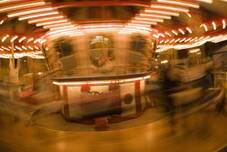"What does this mean? Well, because we are fifteen seconds “in the past,” our brain doesn’t know what’s happening. So, it makes predictions based on evidence."--Maia Cavagnolo, 6th grade

Did you know that we are stuck in the past? Well, our brains are at least. According to Mauro Manassi, who wrote an article about this on the Science Alert called “Our brains keep us 15 seconds ‘in the past,” “Our eyes are continuously bombarded by an enormous amount of visual information - millions of shapes, colors, and ever-changing motion all around us. For the brain this is no easy feat.” Try taking a video of the room you’re in, make sure you spin it around quickly. Now watch it. That is what our brains are processing. So how does it seem like we are in a stable environment?

Well, it’s just like “live” TV. It’s not actually live, it’s three seconds behind, so if anything happens, the producers can edit it. Our brains put us fifteen seconds behind so it can smooth over any mishaps in our perception. Pavle Marinkovic wrote something very interesting on this topic. He said, “It’s like looking at the stars. What we see is something that happened millions of years ago, and those celestial bodies could have already disappeared and we won’t know it for years to come.” This is because stars are so far away, it takes millions of years for their light to reach us.
Think of it like catching a ball. The ball goes faster than your brain’s perception. If that’s true, then how can athletes ever hit the ball? One study shows that the brain predicts where an object will be, and that’s how an athlete can hit a ball, even if it's going extremely fast. The article that Marinkovic wrote relates to that phenomenon. “We might not actually see where the ball is, but luckily, the brain makes accurate predictions that help us respond effectively, thus hitting it precisely. The brain extrapolates the ball’s position along its perceived trajectory, which means that the brain is constantly predicting and filling up the gaps.” Hinze Hogendoorn wrote something called What You’re Seeing Right Now is the Past, so Your Brain is Predicting the Present that really backs this up. “In other words, the brain was ‘seeing’ the object based on where it expected the object to be, rather than based on real information from the eyes.”
Think of it like catching a ball. The ball goes faster than your brain’s perception. If that’s true, then how can athletes ever hit the ball? One study shows that the brain predicts where an object will be, and that’s how an athlete can hit a ball, even if it's going extremely fast. The article that Marinkovic wrote relates to that phenomenon. “We might not actually see where the ball is, but luckily, the brain makes accurate predictions that help us respond effectively, thus hitting it precisely. The brain extrapolates the ball’s position along its perceived trajectory, which means that the brain is constantly predicting and filling up the gaps.” Hinze Hogendoorn wrote something called What You’re Seeing Right Now is the Past, so Your Brain is Predicting the Present that really backs this up. “In other words, the brain was ‘seeing’ the object based on where it expected the object to be, rather than based on real information from the eyes.”

What does this mean? Well, because we are fifteen seconds “in the past,” our brain doesn’t know what’s happening. So, it makes predictions based on evidence. Hogendoorn provides another example;“When a moving object disappeared (for example, by moving clockwise in a circle and disappearing at the twelve o’clock position), our recordings showed that for a while, our participants’ brains acted exactly as if the object was still there and still moving in the one o’ clock position.” So, basically, we can see the future!
That is a lot of information, so here is a sentence from Hogendoorn’s article that sums up this whole paragraph in a couple of words: “It takes time for information from our eyes to reach our brain, where it is processed, analysed and ultimately integrated into consciousness. Due to this delay, the information available to our conscious experience is always outdated.”
The article that you just read only covers a small portion of how we are stuck in the past, and an even smaller amount of information about how the brain works. If you want, you can do more research for yourself and find even more amazing and weird phenomenons. Just make sure that next time you walk outside to notice everything around you, and wonder what is really going on in your brain.
That is a lot of information, so here is a sentence from Hogendoorn’s article that sums up this whole paragraph in a couple of words: “It takes time for information from our eyes to reach our brain, where it is processed, analysed and ultimately integrated into consciousness. Due to this delay, the information available to our conscious experience is always outdated.”
The article that you just read only covers a small portion of how we are stuck in the past, and an even smaller amount of information about how the brain works. If you want, you can do more research for yourself and find even more amazing and weird phenomenons. Just make sure that next time you walk outside to notice everything around you, and wonder what is really going on in your brain.

